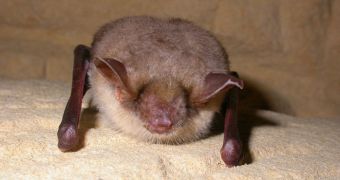Most people know that bats tend to go out at night, foraging around for various types of foods. But not many people know that the winged creatures also need sunlight to go around. A new study has determined that they tend to use sunlight as a tuning device for their internal compasses, the ones that allow them to fly while blind, without slamming themselves strongly against walls and people's faces. The bats' long-distance navigation abilities are known to be impaired by magnetic fields, but thus far a correlation with the Sun has not been made, Wired reports.
“Recent evidence suggests that bats can detect the geomagnetic field. We demonstrate that homing greater mouse-eared bats calibrate a magnetic compass with sunset cues,” say Richard Holland, Ivailo Borissov and Bjorn Siemers, three ornithologists and bat experts from the Max Planck Institute, in Germany. They published the results of their most recent study in a paper appearing in the March 29 issue of the esteemed publication Proceedings of the National Academy of Sciences (PNAS).
In previous investigations, the team proposed that the bats must sense the magnetic field that the planet generates. They tested this idea in the lab, and learned that strong magnetic fields indeed disturb the animals. However, the details of how this took place remained unknown until recently. Their study was prompted by their curiosity to learn how bats travel for dozens of miles away from home each night. The creatures use echolocation to travel short distances, but this ability does not function in the long run. So the team took to rigorously testing how bats got around.
For the recent investigation, some 32 greater mouse-eared bats were captured and then analyzed. In the experiments, half of the bats were removed from nature at twilight, while the other half at night. They were then disoriented, by being placed between coiled magnets that produced a magnetic field that was not aligned to the one our planet produces. Upon being released, those that were captured at night managed to return home straight away, as they had already calibrated their compasses the previous twilight. The other group could not find its way home, as they were trapped before they could have done the tuning.
“The cues used by the bats to indicate their position can only be speculated on at this stage. For animals that occupy ecological niches where the sunset is rarely observed, this is a surprising finding,” the authors add in their journal entry.

 14 DAY TRIAL //
14 DAY TRIAL //